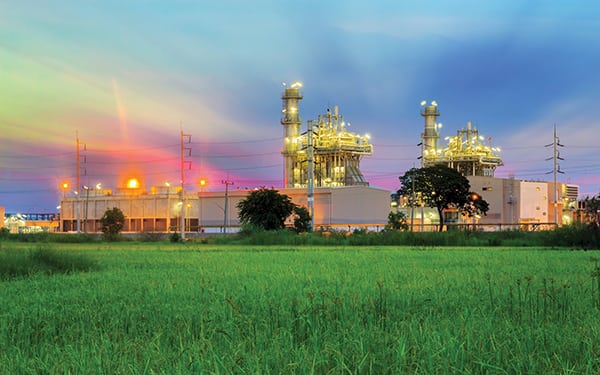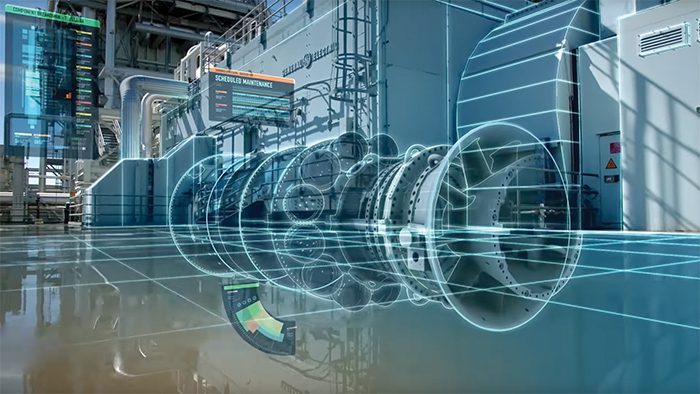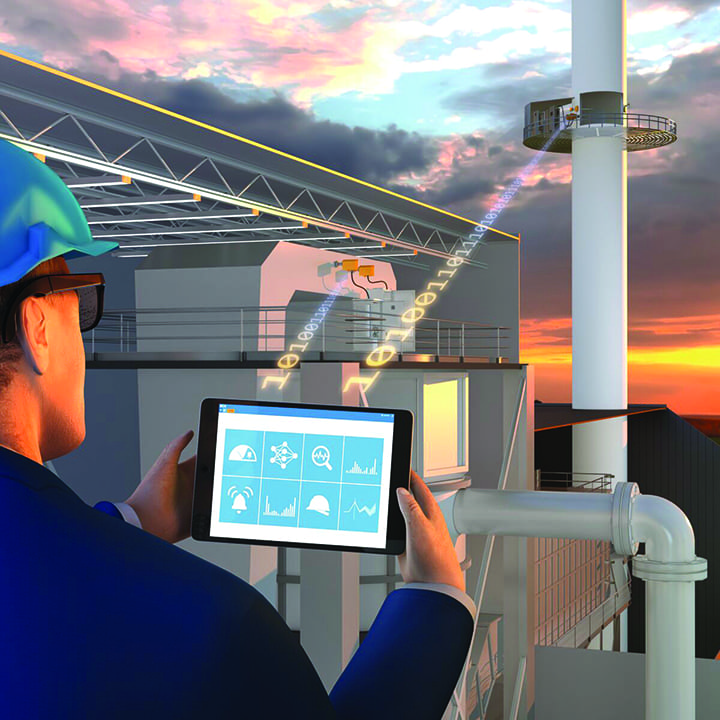As power plant reporting requirements for emissions regulations increase in number and complexity, yesterday’s data collection and reporting systems can make the job harder than it needs to be.
The electrical power generation sector is reportedly the largest source of greenhouse gas emissions in the U.S. As such, it is the focus of the Environmental Protection Agency’s (EPA’s) Clean Power Plan, part of the president’s larger, ambitious Climate Action Plan to reduce carbon emissions. The two clearly demonstrate a trend of environmental regulations that place a high level of importance on the quality of the underlying data, not just on emissions values that are reported. This means increasingly stringent reporting requirements and more data collection.
Increasing Demand for Quality Data
The Acid Rain Program (ARP), established in the amendments to the Clean Air Act in 1990, created the world’s first large-scale emissions trading system. Designed to reduce sulfur dioxide and nitrogen oxides (NOx) from electric generating units (EGUs), this program used a market-based, cap-and-trade approach for achieving reductions. The goal of the program was to allow individual companies to determine the pace of necessary modifications for compliance that met their specific business needs. They could either spend money for emissions control devices or defer installation and purchase allowances from companies that had already achieved reductions through their capital expenditures.
Regulations known as New Source Performance Standards (NSPS), defined under Title 40 in the Code of Federal Regulations (CFR) Part 60, previously existed for EGUs. This part initially governed the quality assurance (QA) checks of instrumentation used to measure the concentration of pollutants. The EPA recognized that the transformation of instrument data from monitoring into a financial instrument suitable for allowance trading required a new level of detailed reporting and data QA.
For this reason, the EPA created a new set of regulations for allowance trading programs that governed the level of QA checks and the required reporting level for data streams that were used in the generation of market-quality data. 40 CFR Part 75 incorporated many facets of Part 60 but expanded the number of quality checks on the instruments. It also augmented the focus of QA checks beyond the emission monitoring instruments to include checks on other types of instruments such as flow monitors providing additional data needed for calculating emissions.
Existing NSPS regulations focused on reporting periods of noncompliance and the steps taken to correct the underlying issues. Part 75 increased the requirements to include the submission of all data at an hourly frequency, not just noncompliant periods.
NSPS required EGUs to report times when instrumentation readings could not be considered statistically accurate. Part 75 required EGUs to report increasingly higher emissions based on the length of time it takes to return their monitoring equipment to proper working order.
Due to the massive amount of data that must be collected, the EPA has developed an electronic reporting platform, the Emissions Collection and Monitoring Plan System, to collect a comprehensive set of emissions as well as supplementary information such as records of every test (completed and failed) along with facility-specific monitoring plans. While at times optional in the past, all utilities are now required to submit their data electronically, which is available for public review.
Part 75 has proven to be a successful model to ensure data quality. Consequently, additional, non-EPA regional market-based programs such as the Regional Greenhouse Gas Initiative, Western Climate Initiative, and the California Air Resources Board refer to Part 75 data requirements.
The scope of Part 75 is not static. As the number and types of parameters to report expand, the level of QA checks and documentation expands as well.
Problems Caused by Increased Data Collection
This trend toward increased reporting parameters continues to grow, placing an enormous burden on facility environmental departments. The volume of data that needs to be collected, aggregated, and reported to satisfy requirements is staggering. Even a small electric power facility (of around 100 MW) requires more than one million complex calculations daily from its air emissions monitoring sources within its property boundaries.
Due to the amount of high-frequency data that has to be reported, data acquisition and handling systems (DAHS) were developed and have been directly connected to environmental analyzers located within the process control network to provide the capabilities for generating electronic reports. Due to the locations of the monitoring systems at the units throughout the facility, control room operators are typically responsible for monitoring real-time compliance, with environmental staff managing the regular reporting and providing any necessary updates to management.
Although large amounts of data are processed and stored at each monitoring location, integration capabilities are lacking at many facilities. Commercial DAHS have existed since the beginning of the ARP and track compliance to generate necessary federal reports for the unit where they are deployed. However, due to the varying age of monitoring equipment and the different manufacturers of systems that can be present in any given facility, a lack of integration leaves many environmental departments gathering data manually into Excel spreadsheets for any unique corporate or state requirements. This can often be the protocol at small and midsize facilities. Complex macros or time-consuming manipulation can be required to aggregate the results. After the data collection and manipulation are completed and passed to others, the spreadsheets are then stored on network drives or within email archives, where they become useless for further analysis.
There are limitations to the effectiveness of these traditional methods. As new regulations are released, it becomes even more challenging for environmental departments to keep current in their coordination with operations. Rather than becoming more efficient, aggregation of information from multiple continuous emissions monitoring systems using different protocols increases with the growth in specialized emissions monitoring systems. Due to the larger variety of systems, some facilities even find it easier to request their own data from the EPA or third-party sources rather than trying to gather significant amounts of information from their multiple facilities. This limits the flexibility and use of the information that is available.
Environmental departments are not the only groups struggling with the need for better transfer of information. Larger market forces such as deregulation have also led to the necessity of establishing methods to share many types of data that formerly never left internal company networks. To help facilitate broader-based data sharing, many large power generation facilities are developing centralized information storage repositories. These systems are designed to interface with multiple data sources, consolidate the information, store it efficiently, and then disseminate it as needed in a format suited for specific audiences.
Unfortunately, the creation of interfaces of environmental data to these systems has been slow, and the information remains in silos, only to be retrieved for compliance monitoring. The stumbling block has been a lack of real-time connectivity between multiple systems storing environmental data and the environmental departments and management.
Integration Advantages
The growing awareness of the value of Part 75–related environmental data, combined with the lack of connectivity between systems isolated on the process control network, has led to the increased adoption of middleware solutions. Some DAHS vendors are creating cloud-based portals that receive the information from multiple instances of their monitoring tools in order to provide a combined view of compliance. Larger utilities have leveraged their existing information systems to provide wider access. These custom solutions are typically based on connecting data historians (such as OSISoft PI) to the Enterprise Reporting Planning solution using commercial middleware packages such as Microsoft’s BizTalk.
In other cases, facilities with strict data security requirements or those facing resource constraints are considering a third option. These solutions, currently being used in the refining and petrochemical industry, are optimized for the long-term storage and efficient transfer of environmental data. Referred to as real-time environmental data management systems (RT-EDMS), these solutions act as custom middleware that provides convenient interfaces to multiple external systems.
They also allow the processing of data based on unique environmental reporting procedures with custom notification capabilities. RT-EDMS serve as the bridge between islands of data contained within multiple DAHS. They enable the retrieval of data by users from multiple locations who might otherwise be restricted from connecting to information stored on the control network. They also provide information in a format accessible to wider platforms (Figure 1).
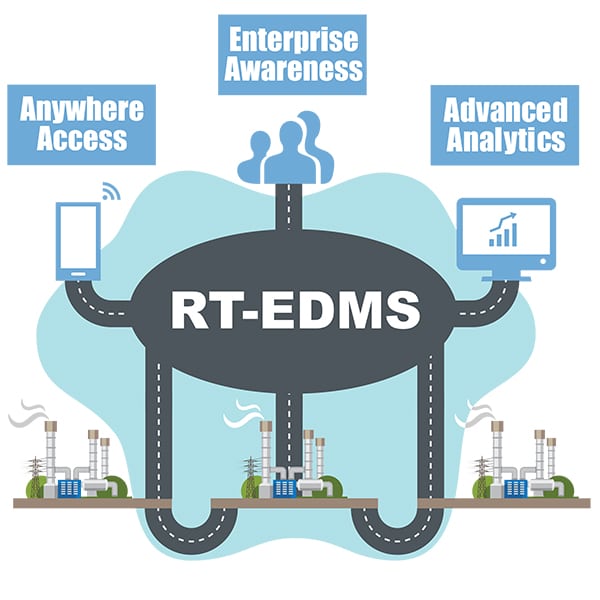 |
|
1. Multiple data and access points. Real-time environmental data management systems (RT-EDMS) serve as the bridge between islands of data. Courtesy: Wood Group |
RT-EDMS have been successfully field-proven in many refining and petrochemical facilities. Users of these systems have consistently shown reductions in time spent compiling custom reports by as much as 90%.
While large power generators might have sufficient resources to develop custom solutions for complete electronic reporting, our research indicates that small to midsize generators (of about 1,000 MW capacity) can especially benefit from these specialized systems in three distinct ways: enterprise awareness, anywhere access, and advanced analytics.
Expanded Awareness Across the Enterprise.Environmental groups and regulatory agencies are not the only stakeholders requiring timely information. While plant operations staff typically have good visibility of real-time compliance information at their facility, corporate environmental staff and executives don’t always have direct access. They are forced to request spreadsheets with the information from sites. If they need data from multiple facilities, the same information frequently arrives in different formats. The result is that custom reports contain the minimal amount of data in aggregate form only. The time it takes to consolidate the information limits the ability to provide on-demand, up-to-date data.
An efficient data management and integration solution like an RT-EDMS allows every audience to access and analyze the entire dataset. Groups that track NOx allowances to evaluate the need to buy or sell offsets can instantly access the most recent information without forcing a specific request (Figure 2). Allocations can be evaluated across multiple facilities to more easily make allowance trading decisions. Employees in operations who field requests for data do not have to spend valuable time trying to gather information that may not be directly useful to them. Comprehensive information requests from regulatory agencies become less time-consuming to respond to.
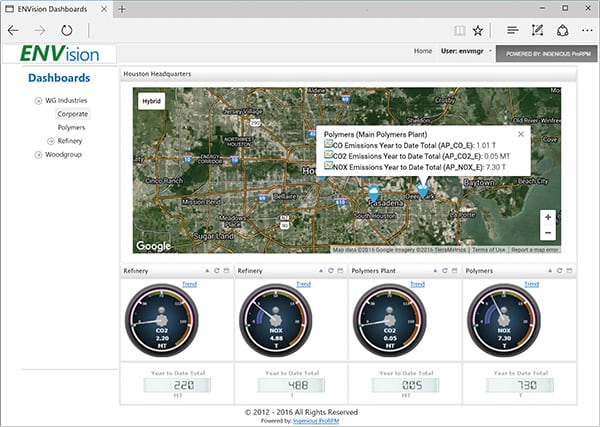 |
|
2. Dashboard convenience. A real-time environmental data management system can provide multiple users with clear access to data from multiple facilities. Courtesy: Wood Group |
Access to Critical Information from Anywhere.With the increased amount of time many people spend away from their computers, it becomes more important to provide information in a manner that is easily accessible and in a format that can easily be consumed on smaller devices. This is especially true for field technicians who rotate among remote facilities. With better connectivity comes the ability to monitor instrument issues and review warnings to determine if an immediate trip is necessary or if the issue can be addressed during the next planned shutdown.
The benefits extend to management as well. As the trend toward mobile devices increases, having access to software installed only on a desktop PC significantly limits the attention that is given to environmental information. Environmental information on mobile executive dashboards with current status, drill-down capabilities and historical summaries is important to maintain a high awareness of the importance of environmental performance. Having that information within familiar tools further facilitates regular review.
Ability to Leverage Advanced Analytics Technology.The exposure of a continuous compliance historical data record from all units across multiple facilities to business intelligence tools opens the possibility of exploring new techniques to find hidden causes of recurring problems. From surveying EGUs, we found that fewer than 25% of large, midsize, and small utilities provide any environmental information directly to outside software packages. The ones that do primarily expose mass emissions to limited groups for allowance projections.
The ability to analyze the results of every QA/QC test on all instrumentation opens up possibilities of identifying trends before they become a problem, alerting management and the responsible department. Combining this information with predictive maintenance systems provides another way to more efficiently identify problems with equipment.
Identifying Specific Value
To determine if facilities can achieve these benefits with an implementation of RT-EDMS software, it is reasonable to first answer these questions:
■ Is there a lack of connectivity between systems? Reporting can be instantaneous, comprehensive, and available for widespread use with an RT-EDMS. Calculating the number of current data requests and the time required to produce them can provide one way to monetize the benefit of an RT-EDMS.
■ How many systems need interfacing, and what is the age of each system? Information from older and legacy equipment, especially at small EGUs, can be more challenging to gather. Investing in integration quickly reduces the reporting effort.
■ Are there additional reporting requirements beyond those required by Part 75 that are difficult to meet with existing systems? Is there some equipment in the facility where exclusive Part 60 reporting is still important? How difficult to understand is any logic embedded in Excel macros that were developed to meet those unique requirements? With the increasing movement of talent and resources, knowledge needs to be embedded in systems that are easily understood by others who were not the initial creators.
■ Has there been a history of enforcement actions by regulatory agencies? To respond to the increased scrutiny and scope of regulatory audits, better reporting software and systems can offset future penalties and improve plant safety and relations with the community.
As the EPA and other regulatory agencies continue to augment their reporting requirements and enhance the frequency and scope of their audits, data volume increases and consistency is required. The necessity of implementing a transparent, real-time, and fully integrated system becomes more imperative. In addition to the reporting agencies, this approach better serves facility employees, management, and the public. ■
—Philip Black, PE (philip.black@woodgroup.com) heads the environmental practice for Wood Group Mustang, a full-service consulting and systems integration firm, where he has helped develop the company’s ENVision environmental management and analytics software suite.


